Hodoeporicon Ruthenicum
by Dr Rima Greenhill, Stanford University
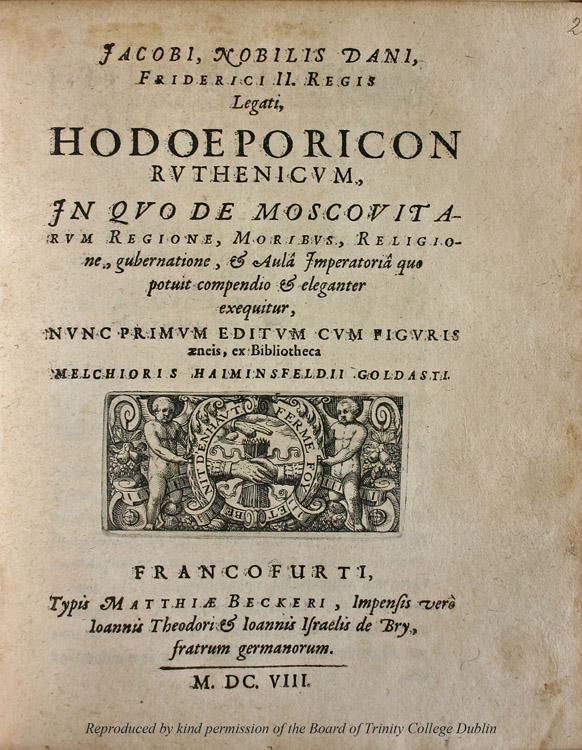
Although its publication is veiled in mystery, the importance of Hodoeporicon Ruthenicum as source of knowledge about Russian society and mores cannot be overestimated. Ulfeldt wrote the manuscript in Denmark in 1588. It was later found in Lyon, France in 1601, by Melchior Goldast von Haiminsfeld (1578-1635), a Swiss humanist and editor of texts on early German history. In 1608, Goldast published Ulfeldt’s Hodoeporicon Ruthenicum in Frankfurt, identifying the author as:
Jacobi, Nobilis Dani, Frederici II. Regis Legati.
A second edition followed in 1627. Both editions contain five illustrations by Johann Theodor de Bry and his brother Johannes Israel. These were not part of the original manuscript now kept in the Danish royal library. No doubt Goldast felt that the added illustrations by famous engravers would increase the book’s marketability.
Jacob Ulfeldt (1535?–1593) belonged to one of the oldest Danish noble families, whose members had been King’s councilors since the 13th c. His childhood coincided with a turbulent time in Danish history, during which Denmark was racked by political and religious turmoil resulting from the rupture with Rome. In 1536, King Christian III (r 1534-1559) had embraced Lutheranism, at exactly the same time as Henry VIII in England had broken with Rome. Ulfeldt was among the first generation of zealous Danish Lutherans, and his reaction to other religions, specifically Russian Orthodoxy discussed in this text, reflected the Reformation bred intolerances of his day.
Like other young members of the Danish aristocracy, Jacob received his education abroad. In the mid-1550s he studied at the Universities of Leuven and Wittenberg, where he became familiar with classical and liturgical literature, and fluent in Latin, Greek and several European languages. His erudition and education are evident throughout Hodoeporicon Ruthenicum. He had three sons, the first of whom was to become Chancellor of Denmark under Christian IV (r 1588-1648) and an important and well-traveled diplomat.
Ulfeldt started his career as a naval officer during the Seven Year War between Denmark and Sweden (1563-1570) and had become a member of Frederik II’s Privy Council by its end. He then began his career as a diplomat and participated in the negotiations over England’s use of Danish waters for its Russian trade. England had been trading with Russia via the North Sea route since their initial contact in 1553, but Denmark strongly objected to this, and would often blockade English ships in their attempt to reach Russia. Through these negotiations Ulfeldt gained an intimate insight into Baltic political affairs and especially Russo-Danish relations. His appointment as ambassador to Russia a few years later followed naturally.
Official Russo-Danish interaction began in the 1490s, as the two countries were united by a shared border and hostility with their common enemy, Sweden. Towards the end of King Christian III’s rule in 1558, however, the two countries began to clash over territories in Livonia (present day Latvia and Estonia). In an effort to secure his much-coveted outlet to the Baltic Sea, Ivan invaded the territories in 1558 and began the protracted and complex Livonian War which lasted for 23 years. Ivan’s army, which consisted primarily of the Tartars, laid siege to Livonian cities and ports and ravished unprepared Livonia in a matter of months. Its population was savagely exterminated or sold into slavery.
Relations between Russia and Denmark deteriorated in the 1570s. What little Denmark had been accorded by the treaty of 1562 was by 1577 once again in Russian hands. That summer Ivan emerged victorious from several military campaigns which he personally commanded. A new entente with Russia was thus a Danish imperative, and a deputation led by Ulfeldt was dispatched to Ivan on 5 May 1578. Its purpose was to induce the Tsar to abide by the agreement of 1562, and also to conclude a permanent peace treaty between Russia and Denmark. Frederik also hoped to secure a joint offensive-defensive alliance with Russia against Sweden. However, Ivan knew that Denmark was severely weakened by its recently concluded war with Sweden, and would not be able to raise an army against him. Ulfeldt was thus unable to achieve the Danish goals and was unsuccessful in his mission. Moreover, the Russian version of the treaty handed to Ulfeldt was significantly at odds with that proposed by the Danes. Shaken by what he had witnessed and the treatment he had received at Russian hands, Ulfeldt returned to Denmark in January 1579. He carried with him the Russian text of the treaty, which required the signature of the Danish monarch. The angry Frederik considered the terms totally unacceptable and refused to ratify it. The document remained unsigned, and Russo-Danish relations reached a stalemate precariously close to war.
The situation only improved with a reversal in Ivan’s Livonian fortunes. Under the energetic leadership of the new Polish king Stephan Bathory, Ivan began to suffer substantial losses, and by the early 1580s was forced to consign all the Livonian territories still in his possession to Poland and Sweden.
The fiasco of 1578 marked an end to Ulfeldt’s here-to-fore brilliant political and diplomatic career. Shunned by the angry king, he lost his influence at court and was forced into a reluctant retirement. He spent the rest of his life on the reconstruction of his country estate and literary endeavors, which included a new History of Denmark. When Frederick died in 1588, Ulfeldt considered it a propitious moment to reestablish his political career and regain his influence at court.
To justify his conduct in Russia, Ulfeldt prepared an account of his activities there. In it he placed special emphasis on the difficulties that accompanied that mission, and the obstacles presented by the Russian authorities. He submitted the report to the regency council with a request that it be published. The council reviewed the matter, and consented to publication on condition that the instructions issued to Ulfeldt on his departure to Russia be included in the volume. The purpose was clearly to demonstrate that he had utterly disregarded them during his negotiations with the Russians. In response, the disillusioned Ulfeldt initially abandoned his publication plan. However, the introduction to the 1627 second edition of Hodoeporicon Ruthenicum states that Ulfeldt had submitted the initial manuscript to the famous Geneva printer Henri Estienne II. How that document then appeared unexpectedly in Lyon in 1601 remains a complete mystery.
Hodoeporicon Ruthenicum is in the form of a chronological travel narrative and combines a description of Ulfeldt’s diplomatic duties with an account of Russian geography, economy and mores, about which he had an astute eye for interesting and relevant details. He offers observations on the treatment of foreign envoys at the Russian court, sheds light on idiosyncrasies of Ivan’s behavior and his entanglement with foes, and provides generally hostile comments on the behavior of Russians and their morals in the late-16th c.
Ulfeldt recorded that the voyage was fraught with deprivations, severe discomfort, physical danger, and hunger. The delegation set out from Denmark on 9 May 1578, and experienced a dangerous sea voyage, sustained considerable damage to their vessels, and barely arrived safely in Livonia on 26 May. There they witnessed the area’s devastation at Russian hands. They observed unspeakable suffering by the local population: people with nothing to eat but grass and bread made of chopped hay and straw. They traversed villages burned and ransacked by Russian or Swedish soldiers.
Russia was then a large and backward country, with Ivan perpetually at war with his neighbors and enemies, Poland, Sweden and the Crimean Tartars. Ulfeldt confirmed Ivan’s martial predisposition and emphasized that the Russians were constantly conscripted to defend their borders. Hodoeporicon Ruthenicum details the conflicts between Ivan and one of his greatest enemies, the Swedes.
As an eyewitness to the consequences of the appalling atrocities, Ulfeldt was shocked by the ever-present evidence of Ivan’s cruelty, and questioned how any ruler could be so indifferent to the suffering of his subjects. In this respect, his account closely echoes the pamphlets then in circulation throughout Germany, which graphically depicted the horrors of impalement, dismemberment, roasting and other creative forms of punishment the Russian Tsar was known to inflict upon his real and imaginary enemies. Hodoeporicon Ruthenicum teems with stories of Russian atrocities and the suffering of the Livonian population. Ulfeldt laments that the Russian authorities did not permit him to alleviate their suffering, and concludes that no one could expect Ivan to be any less cruel towards his enemies when he was so unbearably vicious towards his own people.
Ulfeldt was well aware that Ivan’s forces were mainly composed of Tartar warriors. He believed these Tartar hordes to be not only inhumanly cruel, but also unbearably ugly and repulsive. He reports with disgust on their matrimonial customs, as when one of the Tartars confided to Ulfeldt through an interpreter that he only owned ten wives of German, Russian and Tartar origin. The devout and virtuous Dane considered this to be pure fornication and proof of barbarism and profound immorality.
Ivan’s bizarre forms of punishment and his profligate sexual exploits were legendary. More tales of Ivan’s private life occur in Hodoeporicon Ruthenicum. In his characterization of Ivan's debauched life, Ulfeldt focuses on the Tsar’s sexual excesses. He notes that the Tsar was accustomed to taking fifty or more concubines with him on his campaigns, many of them virgins abducted from Livonian noble families. Ulfeldt further discloses Ivan’s penchant for sharing these women with his sons and others in his entourage.
Of further importance is the Hodoeporicon Ruthenicum as a source of information about Russian society and mores. Ulfeldt notes the beauty of Pskov, and explores the local economy, listing its raw materials such as wax, linen and hemp. When he reaches Novgorod, Ulfeldt presents a historical reflection on its importance and former glory as the international trading center, free from its subservience to Moscow. He offers a graphic picture of the Novgorod of 1578, which still displayed devastation from Ivan’s infamous punitive campaign of 1570, which had left rivers choked with corpses.
Mistreatment of the envoys is a constant refrain in Hodeoporicon Ruthenicum. Ulfeld describes how they were constantly abused by their Russian hosts. This echoes identical complaints in contemporary English accounts. Ulfeldt complains of the enforced absence of contact with the local population; of their confinement as virtual prisoners by the pristavs – the Russian constables charged with the provision of food supplies to the foreign envoys, and more importantly, with the monitoring of their every movement. The Danish delegation on frequent occasions suffered from shortages of food and drink, but was prohibited from buying supplies from local merchants. Ulfeldt recounts the sad story of a Russian who was severely punished for selling milk to the Danish envoys.
Ulfeldt also elucidates Ivan’s turbulent relationship with Duke Magnus of Holstein, the wayward and rebellious brother of Frederik II. He offers further unique insights into rituals at the Russian court, such as the Russian obsession with mead, which would be served at the end of every meal. Ivan’s love of the French malmsey is also mentioned, as are details such as Ivan’s offer of a glass of it to Ulfeldt during a royal audience.
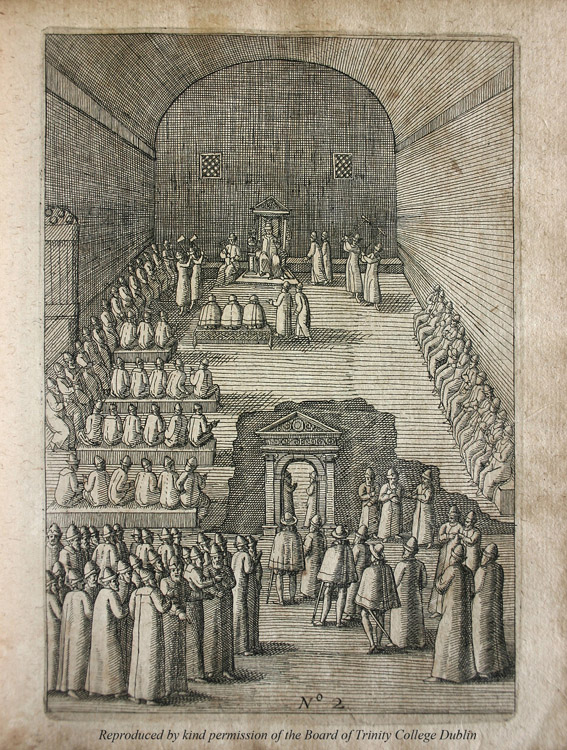
The reception of Ulfeldt’s delegation by Ivan.
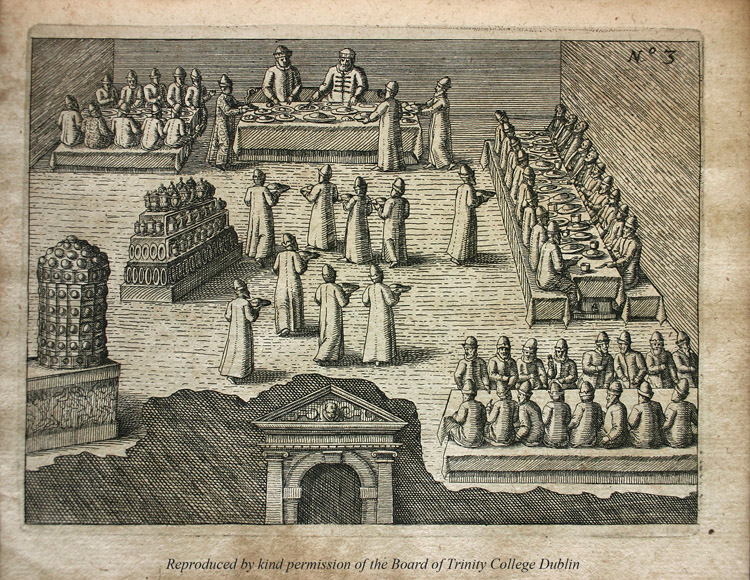
A feast at Ivan’s court.
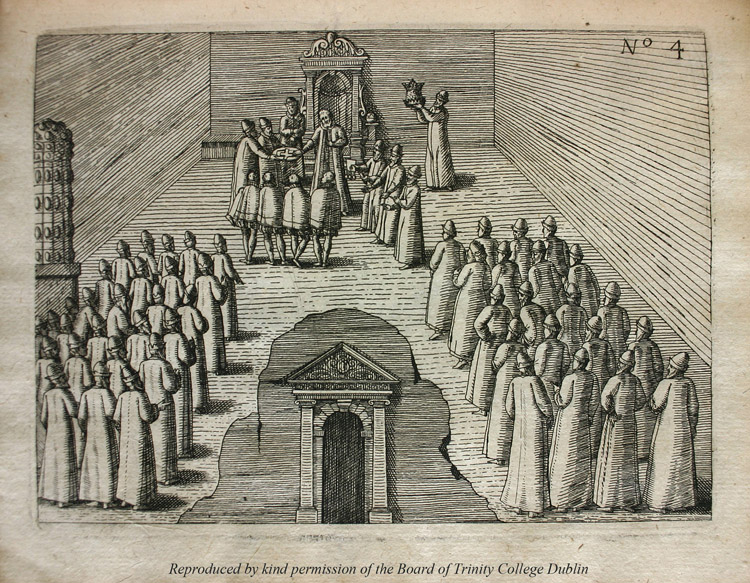
The ceremony of kissing the cross to legally ratify the agreement.
Ulfeldt reported a new fetish at the Russian court. Ivan was extremely proud of a golden orb recently added to his regalia, and loved to hold it in his right arm. This detail was important enough for the de Bry brothers to include as one of their five illustrations.
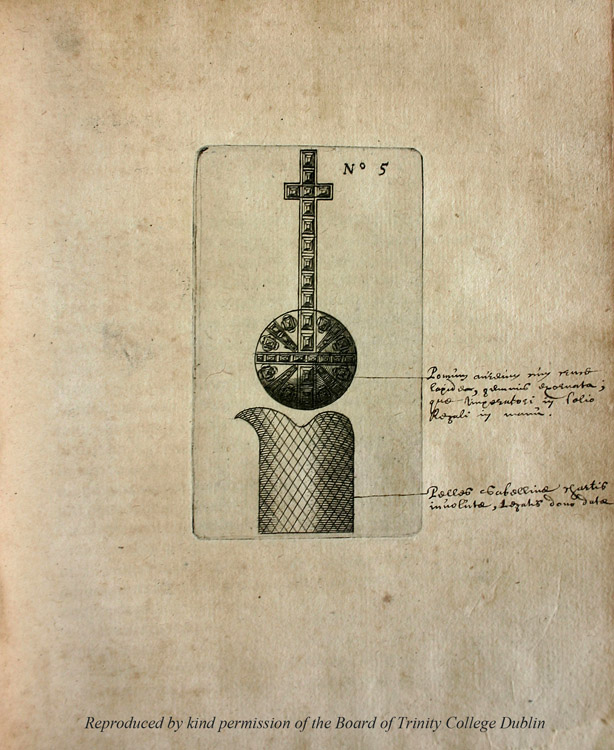 A further insight not found elsewhere in foreign descriptions of Russia is that of Aleksadrovskaya Sloboda. This was the headquarters of the dreaded Oprichniki, the private army-secret police force created by Ivan in 1565, and staffed by his fiercely loyal and often loathsome lackeys. Ulfeldt had not been the only foreigner to visit Aleksandrovskaya Sloboda. The English envoy Thomas Randolph, for example, visited it during his mission of 1568. However, Randolph, much to the disappointment of Russian and English historians alike, was too astute a diplomat to include a written account of it even in his report to the Queen, intended for her eyes only. Ulfeldt, however, is not reticent to share his impressions and takes us inside this citadel of human depravity. The first of the five illustrations in Hodoeporicon Ruthenicum is a bird’s eye view of the fortress, which documents its architecture and extensive rows of Russian guards placed as human barriers surrounding travelers entering its gates.
A further insight not found elsewhere in foreign descriptions of Russia is that of Aleksadrovskaya Sloboda. This was the headquarters of the dreaded Oprichniki, the private army-secret police force created by Ivan in 1565, and staffed by his fiercely loyal and often loathsome lackeys. Ulfeldt had not been the only foreigner to visit Aleksandrovskaya Sloboda. The English envoy Thomas Randolph, for example, visited it during his mission of 1568. However, Randolph, much to the disappointment of Russian and English historians alike, was too astute a diplomat to include a written account of it even in his report to the Queen, intended for her eyes only. Ulfeldt, however, is not reticent to share his impressions and takes us inside this citadel of human depravity. The first of the five illustrations in Hodoeporicon Ruthenicum is a bird’s eye view of the fortress, which documents its architecture and extensive rows of Russian guards placed as human barriers surrounding travelers entering its gates.
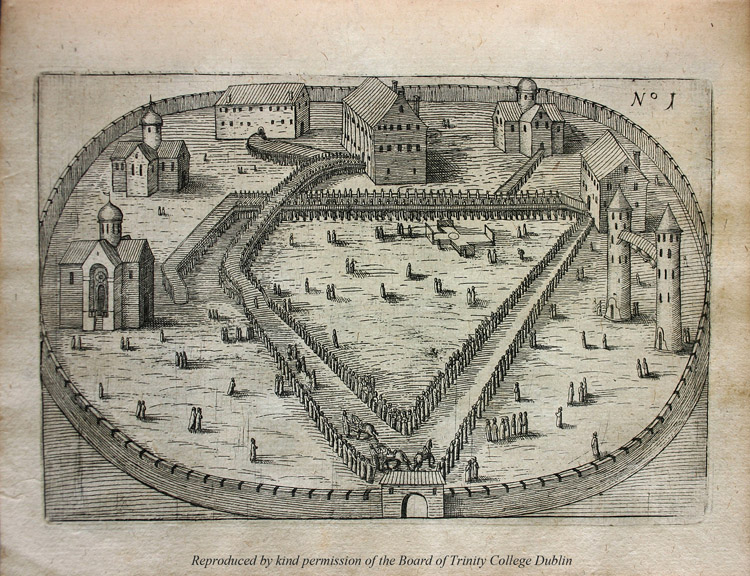
The Russian religion is also closely examined, and Hodoeporicon Ruthenicum is a valuable source of information on contemporary Russian religious practices. As a staunch Lutheran, Ulfeldt is very critical of Russian Orthodoxy which Protestant nations, such as England and Denmark, saw as a painful reminder of their recently rejected Roman Catholic traditions. To them the Russian faith was akin to Catholic doctrine, and Ulfeldt is quick to accuse the Russians of ‘Papism’ and false religious activities such as the worship of icons, which he viewed as idolatry. Ulfeldt was further dismayed when Orthodox clergy refused the ‘unworthy’ Danes admittance into a Russian monastery.
Closely related to the criticism of Russian religious dogma are the envoy’s unflattering comments on the personal characteristics of Russians. In addition to the usual accusations of widespread drunkenness, promiscuity, lying and thievery, Ulfeldt was particularly distressed by the apparent absence of such qualities as decency, propriety, shame and chastity. According to him, Russians were completely devoid of these qualities, which he viewed as indisputable Christian virtues. As for the Tartar contingent of Ivan’s army, he openly dismisses them as ‘heathens’.
Ulfeldt concludes his work with praises to God for sparing his party’s life and delivering them from Ivan’s embrace. He then adds to Ivan’s popular nickname ‘the Muscovite’ that of ‘cruelest Pharaoh.’ Ivan’s abuse of his absolute power appeared in Ulfeldt’s judgment, as in the eyes of many other Western envoys, to be that of a primitive, indulgent, tyrannical and quasi-oriental despot.
Hodoeporicon Ruthenicum is akin to Sigismund von Herberstein’s Rerum Moscoviticarum Commentarii (1556 & 1557 editions of which are found in the Trinity College Dublin Library), and Giles Fletcher’s Of the Russe Commonwealth (1591). These all contributed crucial knowledge about Russia in the late 16th c. Thus Ulfeldt’s book served as a guide and informational source about this strange land for prospective visitors and ambassadors. Moreover, the most frequently quoted book on 17th c. Russia, The Travels of Olearius, first published in 1647, contains frequent references to Hodoeporicon Ruthenicum.
The first Danish translation of the text, entitled Reyse i Ryssland, appeared in 1688. The book was translated into Russian for the first time in 1889, followed more than a century later by another, that of L. N. Godovikova, published in 2002.
To see the catalogue entry for Hodoeporicon Ruthenicum click here.
Bibliography:
- Bruun, H. “Jacob Ulfeldt”. Dansk biografisk lexikon (3rd ed.), Copenhagen, 1984. (in Danish)
- Kirby, David. Northern Europe in the Early Modern Period. The Baltic World 1492-1772. New York: Longman, 1990.
- Kirchner, Walter. “A Milestone in European History: the Danish–Russian Treaty of 1562.” Slavonic and East European Review. American Series, Vol. 3, No. 2 (1944): 39-48.
- Madariaga, Isabel de. Ivan the Terrible: First Tsar of Russia, New Haven and London: Yale University Press, 2005.
- Olearius, Adam. The Travels of Olearius in Seventeenth-Century Russia (trans. and ed. by Samuel H. Baron), Stanford: Stanford University Press, 1967.
- Russow, Balthasar. The Chronicle of the Province of Livonia (trans. by Jerry C. Smith, Juergen Eichhoff, William Urban). Madison: Baltic Studies Center, 1988.
- Shcherbachev, Yu. N. Dva posol’stva pri Ioanne IV Vasil’eviche. (Two Embassies during the Time of Ivan IV) St. Petersburg, 1887. (in Russian)
- Yakob Ul’fel’dt. Puteshestvie v Rossiyu, (Journey to Russia) (eds. J. Lind and A.L. Khoroshkevich, trans. by L.N. Godovikova). Moscow: Yazyki slavyanskoy kul’tury, 2002. (in Russian)